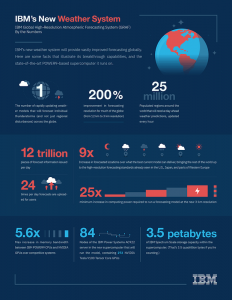On January 11th, IBM announced that they will soon be introducing the world’s highest-resolution global weather forecasting model later in 2019. Known as the IBM Global High-Resolution Atmospheric Forecasting System (GRAF), the model will be the first of its kind with hourly-updating capabilities, with the ability to predict something as small as a thunderstorm virtually anywhere on the planet.
The current top global forecasting models, the European (ECMWF) model and the U.S. GFS model, subdivide the global atmosphere into grid boxes that average 9 kilometers and 13 kilometers on a side. Respectively, they solve the mathematical equations of atmospheric flow to generate a forecast for each of those grid cells.
The new GRAF model employs a variable-resolution grid, resembling a honeycomb, that can be configured with higher resolution over areas of particular interest. Over land areas, the GRAF grid elements will have average resolutions of 3 km, which is about 3 – 4 times greater than the European and GFS models.
Previous global models have always been forced to use what are called “convective parameterization” schemes to approximate what is going on with thunderstorms within each individual grid box, since numerous thunderstorms could be present within the box. These schemes can be a major source of error in weather forecasts.
GRAF, on the other hand, will achieve what has been something of a ‘holy grail’ for global numerical weather forecasting – the ability to run at such a fine resolution that no approximations will be needed to simulate how individual thunderstorms behave. The new GRAF model does not need a convective parameterization scheme when running at 3 km resolution, since the model will permit the existence of individual thunderstorms. In many cases, this will allow the model to make more accurate forecasts in situations where thunderstorms are present.
In comparison, GRAF will run hourly where the GFS models run in six-hour intervals, and the European model runs at 12-hour intervals. NOAA’s High-Resolution Rapid Refresh (HRRR) model does run hourly at 3-kilometer resolution, but only covers the U.S. The new GRAF model will be like the HRRR model, but global in coverage.
Initially, the highest-resolution version of the GRAF model will run at least 12 hours into the future; a lower-resolution version now being tested extends out as far as 120 hours. Verification data to show the accuracy of the forecasts is not yet available, but is expected closer to the end of the year once the model becomes fully operational. It will be extremely interesting to see how well GRAF does with rainfall forecasts for landfalling hurricanes. This is a critically important quantity to get right, as we saw with Hurricane Florence in 2018 and Hurricane Harvey in 2017.
Weather has an impact on almost everything people do. Travel, food choices, even how one feels, can all be weather related. It is arguably the single most important external swing factor in business performance, potentially responsible for nearly half a trillion dollars in economic impact each year in the U.S. alone.
Becoming more commonplace is the reporting of extreme weather events like droughts, wild fires, heavy rainfall, and floods. Because of this, the population needs better, more accurate, more finely-tuned weather forecasts.
GRAF represents a huge step forward. Not only will this much-improved weather system help people and communities better plan for upcoming weather conditions, it will help:
- Utility companies to better position repair crews to get power back faster after a storm
- Airlines to more effectively route around turbulence
- Farmers to better anticipate and prepare for dramatic shifts in weather
- Insurers to predict surges in weather-related claims
- Retailers to stock their shelves more efficiently
In summary, the new Global High-Resolution Atmospheric Forecasting System model is a promising new addition to the weather forecasting business. What is especially unique, is the potential for the model to utilize the power of the Internet to bring in additional high-resolution crowd-sourced data. Anybody with The Weather Channel or Weather Underground app on their smartphone will benefit from the improved forecasts and can help make these forecasts even better by choosing to opt in and share their personal weather station or smartphone weather data.
Universe Kogaku designs and manufactures precision optical lenses for satellite imagery, automated agricultural equipment, security, high tech and electronic applications. We stock 1000’s of standard lens assemblies and can custom design a solution for scanners, CCTV, CCD/CMOS, medical imaging, surveillance systems, machine vision and night vision systems.